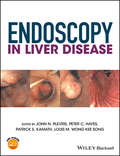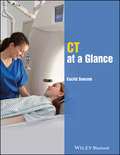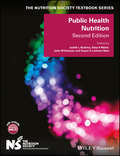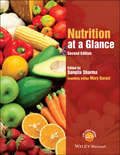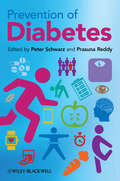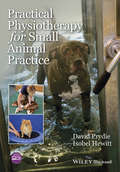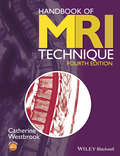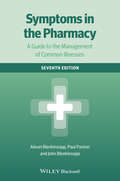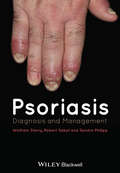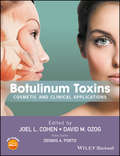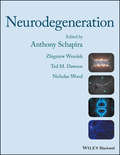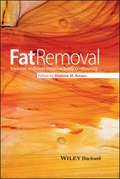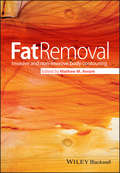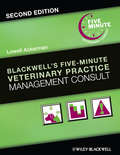- Table View
- List View
Endoscopy in Liver Disease
by John N. Plevris Peter C. Hayes Patrick S. Kamath Louis-Michel Wong Kee SongLiver disease is an increasingly common cause of mortality, and its management is often complex and challenging. Endoscopy has in recent times undergone a period of rapid progress, with numerous novel and specialized endoscopic modalities that are of increasing value in the investigation and management of the patient with liver disease. As the technology in endoscopy expands, both as a diagnostic and interventional procedure, so does the role of the endoscopist in liver disease. This full colour book and companion website offer a comprehensive guidance as to when, why, and how to perform endoscopy to best manage your patients. Brings together two key areas – liver disease and endoscopy – into one expert clinical textbook Covers the entire spectrum of clinical problems that gastroenterologists and endoscopists face while managing patients with liver disease Includes the latest management guidelines from the key international societies, such as the ASGE, AASLD, EASL and BSG Well illustrated with over 150 high-quality colour images 11 high-quality videos illustrating optimum endoscopy practice, all clearly referenced in the text An indispensable tool for all gastroenterologists, hepatologists and endoscopists, Endoscopy in Liver Disease is perfect for learning how to perform endoscopy safely and effectively in the patient population with liver disorders.
CT at a Glance (At a Glance)
by Euclid SeeramCT at a Glance gets readers quickly up to speed with the core knowledge and competencies required for computed tomography (CT) scanning, as established by the major radiography organizations around the world, including the ASRT and the CAMRT. This brand new title describes the basic science behind CT with an emphasis on the theory that is essential for practice. Featuring an abundance of illustrations, succinct, straightforward explanations and clear, step-by-step guidance, it includes the fundamental physics, technical principles, and imaging strategies and procedures involved in CT scanning. Over the course of twenty four, concise modular chapters, CT at a Glance covers all the bases for entry-to-practice students, including: The basic physics underlying CT scanning State-of-the-art multi-slice technologies Data acquisition strategies Equipment components—their functions and applications Image reconstruction and image quality control CT dose and dose optimization procedures Quality control fundamentals CT at a Glance is an indispensable learning resource for students in medical imaging technology courses, including those covering radiography, nuclear medicine, and radiation therapy, as well as for biomedical engineering technology students.
CT at a Glance (At a Glance)
by Euclid SeeramCT at a Glance gets readers quickly up to speed with the core knowledge and competencies required for computed tomography (CT) scanning, as established by the major radiography organizations around the world, including the ASRT and the CAMRT. This brand new title describes the basic science behind CT with an emphasis on the theory that is essential for practice. Featuring an abundance of illustrations, succinct, straightforward explanations and clear, step-by-step guidance, it includes the fundamental physics, technical principles, and imaging strategies and procedures involved in CT scanning. Over the course of twenty four, concise modular chapters, CT at a Glance covers all the bases for entry-to-practice students, including: The basic physics underlying CT scanning State-of-the-art multi-slice technologies Data acquisition strategies Equipment components—their functions and applications Image reconstruction and image quality control CT dose and dose optimization procedures Quality control fundamentals CT at a Glance is an indispensable learning resource for students in medical imaging technology courses, including those covering radiography, nuclear medicine, and radiation therapy, as well as for biomedical engineering technology students.
Public Health Nutrition (The Nutrition Society Textbook)
by Judith L. Buttriss John M. Kearney Susan A. Lanham-New Ailsa A. WelchIn this second edition of the bestselling title from the acclaimed Nutrition Society Textbook series, Public Health Nutrition has been extensively revised to ensure that it reflects the latest evidence-based knowledge and research. Ground-breaking and comprehensive in both its scope and approach, Public Health Nutrition has been fully updated by an expert editorial team to cover the most recent changes in the field. It now offers a structured overview of the subject’s core concepts and considers public health nutrition tools and the application of intervention strategies. Divided into five key sections, Public Health Nutrition contains a wealth of information, including: Public health nutrition concepts and assessment tools, and their application in light of the latest evidence. Case studies to illustrate how best to apply the theory and evidence to policy and practice. An examination of nutrition throughout the lifecycle, and the relationship between diet and disease, including in relation to obesity, diabetes, cancer, as well as mental health. The impact of environmental factors on public health. Public health strategies, policies and approaches. With a clear and concise structure, Public Health Nutrition is an essential purchase for students of nutrition, dietetics and other healthcare areas, as well as an invaluable practical guide for health professionals working within public health. A supporting companion website featuring multiple-choice, short answer, and essay style questions is available at www.wiley.com/go/buttriss/publichealth
Public Health Nutrition (The Nutrition Society Textbook #12)
by Judith Buttriss Ailsa Welch John Kearney Susan A Lanham-NewIn this second edition of the bestselling title from the acclaimed Nutrition Society Textbook series, Public Health Nutrition has been extensively revised to ensure that it reflects the latest evidence-based knowledge and research. Ground-breaking and comprehensive in both its scope and approach, Public Health Nutrition has been fully updated by an expert editorial team to cover the most recent changes in the field. It now offers a structured overview of the subject’s core concepts and considers public health nutrition tools and the application of intervention strategies. Divided into five key sections, Public Health Nutrition contains a wealth of information, including: Public health nutrition concepts and assessment tools, and their application in light of the latest evidence. Case studies to illustrate how best to apply the theory and evidence to policy and practice. An examination of nutrition throughout the lifecycle, and the relationship between diet and disease, including in relation to obesity, diabetes, cancer, as well as mental health. The impact of environmental factors on public health. Public health strategies, policies and approaches. With a clear and concise structure, Public Health Nutrition is an essential purchase for students of nutrition, dietetics and other healthcare areas, as well as an invaluable practical guide for health professionals working within public health. A supporting companion website featuring multiple-choice, short answer, and essay style questions is available at www.wiley.com/go/buttriss/publichealth
Nutrition at a Glance (At a Glance)
by Mary Barasi Sangita SharmaNutrition at a Glance introduces key nutrition facts, such as the role of key nutrients in maintaining health, and addresses the concepts of nutrient metabolism, nutritional intake and what makes an adequate diet. It covers food safety, allergy and intolerance, GM foods, diet-related diseases and nutrigenomics.Nutrition at a Glance:• Is superbly illustrated, with full colour illustrations throughout • Includes nutrition ‘hot topics’ such as gene-nutrient interactions and dietary supplements • Has strong international appeal, with different dietary requirements provided for many countries• Is a reference text suitable for post-docs and junior scientists, including those working in public health and dietetics• Includes a companion website at www.ataglanceseries.com/nutrition featuring interactive multiple choice questions, abbreviations, a glossary, references and further reading, and Appendix B 1: Global dietary guidelines and Dietary Reference Intakes
Nutrition at a Glance (At a Glance)
by Mary Barasi Sangita SharmaNutrition at a Glance introduces key nutrition facts, such as the role of key nutrients in maintaining health, and addresses the concepts of nutrient metabolism, nutritional intake and what makes an adequate diet. It covers food safety, allergy and intolerance, GM foods, diet-related diseases and nutrigenomics.Nutrition at a Glance:• Is superbly illustrated, with full colour illustrations throughout • Includes nutrition ‘hot topics’ such as gene-nutrient interactions and dietary supplements • Has strong international appeal, with different dietary requirements provided for many countries• Is a reference text suitable for post-docs and junior scientists, including those working in public health and dietetics• Includes a companion website at www.ataglanceseries.com/nutrition featuring interactive multiple choice questions, abbreviations, a glossary, references and further reading, and Appendix B 1: Global dietary guidelines and Dietary Reference Intakes
Prevention of Diabetes
by Peter Schwarz Prasuna ReddyExpertly authored by the world’s leading specialists in the field, Prevention of Diabetes is the definitive guide for better preventative diabetes care. Using an evidence-based approach, it outlines the very latest in the identification of people at high risk for type 2 diabetes and how best to use interventional methods such as screening at-risk individuals, pharmaceutical intervention and lifestyle changes. In addition, it will provide healthcare professionals with the clinical knowledge required to clearly identify the early symptoms of diabetes, enabling them to provide their patients with better clinical care and helping avoid the onset of full-blown diabetes. Also covered are both the health economics of establishing, and the methods of implement/delivering targeted prevention programmes into clinical and health care practice, based on the vast experience of the editors due to their involvement in such programmes. Prevention of Diabetes provides clear and expert information in a practical, accessible way, and is ideal reading for all those with an interest in the prevention of diabetes and obesity, such as public health workers, specialists in diabetes and obesity, and GP’s seeing patients with early onset or pre-diabetes symptoms.
Prevention of Diabetes
by Peter Schwarz Prasuna ReddyExpertly authored by the world’s leading specialists in the field, Prevention of Diabetes is the definitive guide for better preventative diabetes care. Using an evidence-based approach, it outlines the very latest in the identification of people at high risk for type 2 diabetes and how best to use interventional methods such as screening at-risk individuals, pharmaceutical intervention and lifestyle changes. In addition, it will provide healthcare professionals with the clinical knowledge required to clearly identify the early symptoms of diabetes, enabling them to provide their patients with better clinical care and helping avoid the onset of full-blown diabetes. Also covered are both the health economics of establishing, and the methods of implement/delivering targeted prevention programmes into clinical and health care practice, based on the vast experience of the editors due to their involvement in such programmes. Prevention of Diabetes provides clear and expert information in a practical, accessible way, and is ideal reading for all those with an interest in the prevention of diabetes and obesity, such as public health workers, specialists in diabetes and obesity, and GP’s seeing patients with early onset or pre-diabetes symptoms.
Practical Physiotherapy for Small Animal Practice
by David Prydie Isobel HewittPractical Physiotherapy for Small Animal Practice provides a concise and accessible introduction to physiotherapy that demonstrates its benefits to both veterinary patients and practitioners. One of the fastest growing specialties in veterinary medicine, this book will help you to successfully introduce physiotherapy into your practice improving rehabilitation and recovery of dogs and cats. Key features: Covers an array of different treatments and techniques, such as manual therapies, therapeutic exercise, electrotherapy, and hydrotherapy Includes practical advice on selecting equipment, examinations, treatment protocols, and charging Offers strategies for introducing physiotherapy into the practice schedule, including space and staffing requirements Companion website provides over 50 printable client education handouts for download
Practical Physiotherapy for Small Animal Practice
by David Prydie Isobel HewittPractical Physiotherapy for Small Animal Practice provides a concise and accessible introduction to physiotherapy that demonstrates its benefits to both veterinary patients and practitioners. One of the fastest growing specialties in veterinary medicine, this book will help you to successfully introduce physiotherapy into your practice improving rehabilitation and recovery of dogs and cats. Key features: Covers an array of different treatments and techniques, such as manual therapies, therapeutic exercise, electrotherapy, and hydrotherapy Includes practical advice on selecting equipment, examinations, treatment protocols, and charging Offers strategies for introducing physiotherapy into the practice schedule, including space and staffing requirements Companion website provides over 50 printable client education handouts for download
Handbook of MRI Technique
by Catherine WestbrookNow entering its fourth edition, the market-leading Handbook of MRI Technique has been fully revised and updated to incorporate new technologies and developments essential to good practice. Written specifically for technologists and highly illustrated, it guides the uninitiated through scanning techniques and helps more experienced technologists to improve image quality. The first part of the book considers the main aspects of theory that relate to scanning and also includes practical tips on gating, equipment use, patient care and safety, and information on contrast media. The second half provides step-by-step instruction for examining each anatomical area, beginning with a basic anatomy section followed by sections on indications, patient positioning, equipment, artefacts and tips on optimizing image quality. Written by an international team of technologists from the United States, United Kingdom and Europe Suitable for users for all types of MRI systems Now includes key points throughout for quick reference Companion website at www.wiley.com/go/westbrook/mritechnique with self-assessment and image flashcards Handbook of MRI Technique continues to be the ideal support both for radiographers new to MRI and for regular users looking for information on alternative techniques and suggestions on protocol modifications.
Handbook of MRI Technique
by Catherine WestbrookNow entering its fourth edition, the market-leading Handbook of MRI Technique has been fully revised and updated to incorporate new technologies and developments essential to good practice. Written specifically for technologists and highly illustrated, it guides the uninitiated through scanning techniques and helps more experienced technologists to improve image quality. The first part of the book considers the main aspects of theory that relate to scanning and also includes practical tips on gating, equipment use, patient care and safety, and information on contrast media. The second half provides step-by-step instruction for examining each anatomical area, beginning with a basic anatomy section followed by sections on indications, patient positioning, equipment, artefacts and tips on optimizing image quality. Written by an international team of technologists from the United States, United Kingdom and Europe Suitable for users for all types of MRI systems Now includes key points throughout for quick reference Companion website at www.wiley.com/go/westbrook/mritechnique with self-assessment and image flashcards Handbook of MRI Technique continues to be the ideal support both for radiographers new to MRI and for regular users looking for information on alternative techniques and suggestions on protocol modifications.
Symptoms in the Pharmacy: A Guide to the Management of Common Illnesses
by Alison Blenkinsopp Paul Paxton John BlenkinsoppSymptoms in the Pharmacy is the indispensable guide to the management of common symptoms seen in the pharmacy. Designed for quick and easy reference with separate chapters for each ailment, each chapter incorporates a decision making framework in which the information necessary for treatment and suggestions on ‘when to refer’ is distilled into helpful summary boxes. Decision making support is provided in cases involving ethical dilemmas. It also includes example case studies providing the view of pharmacists and doctors and, in their own words, patient perspectives of what it is like to live with and manage conditions such as migraine and eczema. These easy-to-follow chapters can be read cover to cover or turned to for quick reference. This seventh edition covers the availability of new medicines and includes new sections and case studies for 'POM' to 'P' switches. It continues to draw upon the latest evidence for treatment guidelines and includes expanded coverage of common infectious diseases and important safety advice on the use of medicines in children. It also features colour photographs of skin conditions enabling the differentiation and diagnosis of common skin complaints. With advice from a pharmacist and GP author team, Symptoms in the Pharmacy covers ailments which will be encountered in the pharmacy on a daily basis and should be kept close at hand for frequent consultation.
Symptoms in the Pharmacy: A Guide to the Management of Common Illnesses
by Alison Blenkinsopp Paul Paxton John BlenkinsoppSymptoms in the Pharmacy is the indispensable guide to the management of common symptoms seen in the pharmacy. Designed for quick and easy reference with separate chapters for each ailment, each chapter incorporates a decision making framework in which the information necessary for treatment and suggestions on ‘when to refer’ is distilled into helpful summary boxes. Decision making support is provided in cases involving ethical dilemmas. It also includes example case studies providing the view of pharmacists and doctors and, in their own words, patient perspectives of what it is like to live with and manage conditions such as migraine and eczema. These easy-to-follow chapters can be read cover to cover or turned to for quick reference. This seventh edition covers the availability of new medicines and includes new sections and case studies for 'POM' to 'P' switches. It continues to draw upon the latest evidence for treatment guidelines and includes expanded coverage of common infectious diseases and important safety advice on the use of medicines in children. It also features colour photographs of skin conditions enabling the differentiation and diagnosis of common skin complaints. With advice from a pharmacist and GP author team, Symptoms in the Pharmacy covers ailments which will be encountered in the pharmacy on a daily basis and should be kept close at hand for frequent consultation.
Psoriasis: Diagnosis and Management
by Wolfram Sterry Robert Sabat Sandra PhilippPractical and user-friendly, this is the ideal guide to the diagnosis and treatment of psoriasis, helping you navigate a logical management pathway through a complex maze of possibilities.Psoriasis is a cruel disease that can seriously affect the sufferer’s quality and length of life. It is also highly idiosyncratic, with features that vary greatly from patient to patient; this being mirrored in the highly variable response to treatment. It is increasingly recognized that psoriasis is not a discrete disease and that many patients suffer two or three comorbid conditions that can complicate the efforts of doctors treating patients.Psoriasis: Diagnosis and Management will provide dermatologists of all levels with a practical, well-illustrated approach to fully understanding the disease, including clear, clinical guidance to enable best-practice and effective management of patients.In full color throughout and excellently illustrated, key highlights include: easily understandable description of the psoriasis pathogenesis; a strong emphasis on the clinical features of psoriasis; careful consideration of comorbid conditions as part of the psoriatic spectrum to be managed; coverage of both traditional and contemporary management approaches; plenty of diagnostic algorithms and management protocols to aid the daily practical care of patients. Brought to you by several of the world’s leading authorities on the subject, Psoriasis: Diagnosis and Management is an essential purchase for the dermatologist.
Psoriasis: Diagnosis and Management
by Wolfram Sterry Robert Sabat Sandra PhilippPractical and user-friendly, this is the ideal guide to the diagnosis and treatment of psoriasis, helping you navigate a logical management pathway through a complex maze of possibilities.Psoriasis is a cruel disease that can seriously affect the sufferer’s quality and length of life. It is also highly idiosyncratic, with features that vary greatly from patient to patient; this being mirrored in the highly variable response to treatment. It is increasingly recognized that psoriasis is not a discrete disease and that many patients suffer two or three comorbid conditions that can complicate the efforts of doctors treating patients.Psoriasis: Diagnosis and Management will provide dermatologists of all levels with a practical, well-illustrated approach to fully understanding the disease, including clear, clinical guidance to enable best-practice and effective management of patients.In full color throughout and excellently illustrated, key highlights include: easily understandable description of the psoriasis pathogenesis; a strong emphasis on the clinical features of psoriasis; careful consideration of comorbid conditions as part of the psoriatic spectrum to be managed; coverage of both traditional and contemporary management approaches; plenty of diagnostic algorithms and management protocols to aid the daily practical care of patients. Brought to you by several of the world’s leading authorities on the subject, Psoriasis: Diagnosis and Management is an essential purchase for the dermatologist.
Botulinum Toxins: Cosmetic and Clinical Applications
by Joel L. CohenBotulinum Toxins: Cosmetic and Clinical Applications provides a comprehensive and in-depth review of the use of botulinum toxin for aesthetic procedures and medical applications as a stand-alone treatment and as part of combination therapy. Now a mainstay of cosmetic dermatologic practice, the range of available toxins and their varied applications has grown considerably in recent years requiring the practitioner to carefully consider what approach best suits the needs of their patient. This new book, written by international expert authors, provides guidance to help you refine your technique, add new procedures to your practice, and provide optimal results. This book: Offers guidance on best-practice approaches with botulinum toxin, helping create cutting edge, tailored treatment plans for each patient Benefits from a wealth of color images, procedural videos, and expert tips and tricks Takes a region oriented approach, providing guidance on treatment of the; glabella, forehead, periocular and perioral areas, and contouring of the lower face and lower leg and calf, and neck rejuvenation Contains a thorough review of non-cosmetic treatments such as correction of facial asymmetry, and treatment of axillary hyperhidrosis, plus palm, sole, and craniofacial hyperhidrosis Covers exciting new topics, such as future injectables, topical botulinum toxin, and facial contouring including treatment for benign masseter hypertrophy Discusses combination therapy of botulinum toxin with other non-surgical procedures such as hyaluronic acid (HA) or filler substances, light and laser sources, and other energy-based therapies Includes considerations for darker skin types Offer your patients the best care, stay on top of cutting edge techniques, and avoid pitfalls with coverage of practical tips and real cases. Botulinum Toxins in Dermatology: Cosmetic and Clinical Applications provides best-practice guidance on the contemporary use of botulinum toxin in isolation and in combination.
Botulinum Toxins: Cosmetic and Clinical Applications
by Joel L. Cohen David M. Ozog Dennis A. PortoBotulinum Toxins: Cosmetic and Clinical Applications provides a comprehensive and in-depth review of the use of botulinum toxin for aesthetic procedures and medical applications as a stand-alone treatment and as part of combination therapy. Now a mainstay of cosmetic dermatologic practice, the range of available toxins and their varied applications has grown considerably in recent years requiring the practitioner to carefully consider what approach best suits the needs of their patient. This new book, written by international expert authors, provides guidance to help you refine your technique, add new procedures to your practice, and provide optimal results. This book: Offers guidance on best-practice approaches with botulinum toxin, helping create cutting edge, tailored treatment plans for each patient Benefits from a wealth of color images, procedural videos, and expert tips and tricks Takes a region oriented approach, providing guidance on treatment of the; glabella, forehead, periocular and perioral areas, and contouring of the lower face and lower leg and calf, and neck rejuvenation Contains a thorough review of non-cosmetic treatments such as correction of facial asymmetry, and treatment of axillary hyperhidrosis, plus palm, sole, and craniofacial hyperhidrosis Covers exciting new topics, such as future injectables, topical botulinum toxin, and facial contouring including treatment for benign masseter hypertrophy Discusses combination therapy of botulinum toxin with other non-surgical procedures such as hyaluronic acid (HA) or filler substances, light and laser sources, and other energy-based therapies Includes considerations for darker skin types Offer your patients the best care, stay on top of cutting edge techniques, and avoid pitfalls with coverage of practical tips and real cases. Botulinum Toxins in Dermatology: Cosmetic and Clinical Applications provides best-practice guidance on the contemporary use of botulinum toxin in isolation and in combination.
Neurodegeneration
by Anthony Schapira Zbigniew Wszolek Ted M. Dawson Nicholas WoodThis book unites the diverse range of complex neurodegenerative diseases into a textbook designed for clinical practice, edited by globally leading authorities on the subject. Presents a clinically oriented guide to the diseases caused by neurodegeneration Templated chapters combine clinical and research information on neurodegenerative diseases beginning with the common elements before treating each disease individually Diseases are grouped by anatomical regions of degeneration and include common disorders such as Parkinson’s Disease, Alzheimer’s Disease, Amyotrophic Lateral Sclerosis/Motor Neuron Disease, and Multiple Sclerosis as well as less common diseases Edited by globally leading authorities on the subject, and written by expert contributing authors
Neurodegeneration
by Anthony Schapira Zbigniew K. Wszolek Ted M. Dawson Nicholas WoodThis book unites the diverse range of complex neurodegenerative diseases into a textbook designed for clinical practice, edited by globally leading authorities on the subject. Presents a clinically oriented guide to the diseases caused by neurodegeneration Templated chapters combine clinical and research information on neurodegenerative diseases beginning with the common elements before treating each disease individually Diseases are grouped by anatomical regions of degeneration and include common disorders such as Parkinson’s Disease, Alzheimer’s Disease, Amyotrophic Lateral Sclerosis/Motor Neuron Disease, and Multiple Sclerosis as well as less common diseases Edited by globally leading authorities on the subject, and written by expert contributing authors
Fat Removal: Invasive and Non-invasive Body Contouring
by Mathew M. AvramThe perception of an inadequate body shape is a cause of concern to many people, and new techniques for altering body shape are increasingly being developed and offered to patients. Of these, the removal and transfer of fat is fast growing in importance and availability. This practical guide offers a comprehensive overview of this rapidly-evolving field, and thorough coverage of the implementation of fat removal techniques, both invasive and non-invasive, in a cosmetic practice. It begins with an overview of basic fat anatomy and physiology as an important introduction to this topic. The distinction between the physiology and treatment of cellulite and fat is also discussed. The next section of the book covers invasive treatments of fat such as traditional liposuction, laser-assisted liposuction, fat transfer procedures and mesotherapy. The latter half of the book largely focuses on non-invasive treatments for fat, including radiofrequency, ultrasound, cooling and laser technologies for fat removal. Throughout, potential complications and pitfalls of the various treatments are discussed. Edited by Matthew Avram, with contributions from a group of clinical stars, this book will appeal to cosmetic dermatologists, plastic surgeons, aesthetic medical practitioners, and obstetricians/gynaecologists
Fat Removal: Invasive and Non-invasive Body Contouring
by Mathew AvramThe perception of an inadequate body shape is a cause of concern to many people, and new techniques for altering body shape are increasingly being developed and offered to patients. Of these, the removal and transfer of fat is fast growing in importance and availability. This practical guide offers a comprehensive overview of this rapidly-evolving field, and thorough coverage of the implementation of fat removal techniques, both invasive and non-invasive, in a cosmetic practice. It begins with an overview of basic fat anatomy and physiology as an important introduction to this topic. The distinction between the physiology and treatment of cellulite and fat is also discussed. The next section of the book covers invasive treatments of fat such as traditional liposuction, laser-assisted liposuction, fat transfer procedures and mesotherapy. The latter half of the book largely focuses on non-invasive treatments for fat, including radiofrequency, ultrasound, cooling and laser technologies for fat removal. Throughout, potential complications and pitfalls of the various treatments are discussed. Edited by Matthew Avram, with contributions from a group of clinical stars, this book will appeal to cosmetic dermatologists, plastic surgeons, aesthetic medical practitioners, and obstetricians/gynaecologists
Blackwell's Five-Minute Veterinary Practice Management Consult (Blackwell's Five-Minute Veterinary Consult)
by Lowell AckermanBlackwell’s Five-Minute Veterinary Practice Management Consult, Second Edition has been extensively updated and expanded, with 55 new topics covering subjects such as online technologies, hospice care, mobile practices, compassion fatigue, practice profitability, and more. Carefully formatted using the popular Five-Minute Veterinary Consult style, the book offers fast access to authoritative information on all aspects of practice management. This Second Edition is an essential tool for running a practice, increasing revenue, and managing staff in today’s veterinary practice. Addressing topics ranging from client communication and management to legal issues, financial management, and human resources, the book is an invaluable resource for business management advice applicable to veterinary practice. Sample forms and further resources are now available on a companion website. Veterinarians and practice managers alike will find this book a comprehensive yet user-friendly guide for success in today’s challenging business environment.
Blackwell's Five-Minute Veterinary Practice Management Consult (Blackwell's Five-Minute Veterinary Consult)
by Lowell AckermanBlackwell’s Five-Minute Veterinary Practice Management Consult, Second Edition has been extensively updated and expanded, with 55 new topics covering subjects such as online technologies, hospice care, mobile practices, compassion fatigue, practice profitability, and more. Carefully formatted using the popular Five-Minute Veterinary Consult style, the book offers fast access to authoritative information on all aspects of practice management. This Second Edition is an essential tool for running a practice, increasing revenue, and managing staff in today’s veterinary practice. Addressing topics ranging from client communication and management to legal issues, financial management, and human resources, the book is an invaluable resource for business management advice applicable to veterinary practice. Sample forms and further resources are now available on a companion website. Veterinarians and practice managers alike will find this book a comprehensive yet user-friendly guide for success in today’s challenging business environment.
